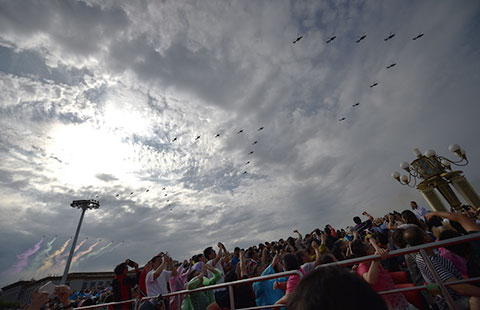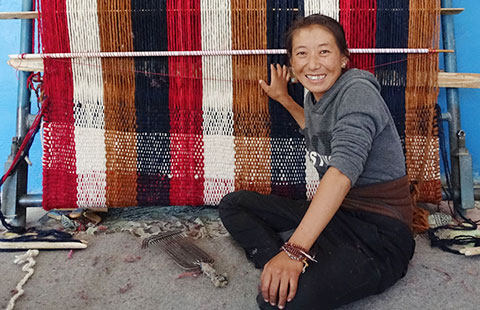Chengdu puts itself on the tourist map
Updated: 2015-08-31 23:31
(China Watch)
|
|||||||||
Chengdu was selected in The New York Times’ list of the world’s 52 must-see places this year. The southwestern city’s inclusion was no doubt largely thanks to a popular travel piece by writer and editor Justin Bergman that was published in the paper in October 2013.
“Beijing may be the political center of China, as well as a cultural and culinary hub,” he wrote, “but the most dynamic Chinese city at the moment is more than 1,000 miles south, in the mountains of Sichuan province.
“Chengdu has one of the fastest-growing economies in China, roughly two-thirds of the world’s iPads are reportedly made here, and there are high-rises as far as the eye can see. But the way of life is much more laid-back than in other large Chinese cities.”
Bergman is not the only person who has been captivated by Chengdu’s charm.
The MasterCard 2015 Global Destination Cities Index, released in early July, also placed the city in its top-10 list of must-see Chinese cities. According to the study, between 2009 and 2015, the annual number of overseas visitors to the city was expected to rise from 480,000 to 1.49 million, making it the second-fastest growing tourist destination in the world, behind only Colombo, the Sri Lankan capital.
“The New York Times’ selection makes the city better known for its legacies, not just its pandas and spicy food,” said Chen Qiankang, a professor of tourism studies at Sichuan Normal University.
The city opened its first direct foreign air route in May 2006, to Amsterdam, and today its airport offers 83 flights to about 190 foreign destinations on five continents, as well as 246 domestic services.
A direct air route to the U.S. was opened last year, greatly shortening the travel distance for American tourists. United Airlines has also increased the frequency of its nonstop Chengdu-San Francisco service from three times a week to daily.
Since 2013, transit passengers from 51 countries and regions have also been able to take advantage of a 72-hour visa-free policy to explore Chengdu.
The local tourist administration said it has applied for approval from Beijing to extend the visa-free policy to eight days and that more exit-entry offices are being set up to meet the needs of residents looking to travel abroad.
Chengdu has 63 national A-class tourist sites, 140 star-level hotels, 5,300 inns and 364 travel agencies, according to the administration.
Official data show the city received roughly 186 million tourists from home and abroad last year, an increase of 20 percent year-on-year. The number of foreign tourists was 1.97 million, up 11 percent, while the revenue from tourism reached 166.5 billion yuan ($26.7 billion), up 25 percent.
The China Tourism Academy placed Chengdu fourth out of 60 major Chinese cities in terms of tourists’ evaluation in its annual report in January, the fifth consecutive year the city has been ranked in the top five.
“Beautiful landscapes and places of historic interest attract tourists to Chengdu, but it’s the thoughtful services and comfortable life that move them to stay longer,” said Zhang Youyin, a researcher in tourism development for the China Tourism Academy.
He said the city has great potential to develop and attract more foreigners.
“Chengdu should have faster broadband Internet, develop a network platform to serve foreign travelers, and make public information in railway stations, airports and tourist sites more foreigner-friendly,” he added.
The Chengdu government also plans to build the city into a world-class shopping destination. The city has been an industrial and commercial center since the early Tang Dynasty (A.D. 618-907), and it is known as the capital of brocade embroidery and a starting point for the ancient Silk Road, which connected Asia with Europe. Today, more and more international brands have a presence in the Sichuan capital.
“When I was free from my work, I often went shopping abroad,” said He Xiaoxiao, an airline stewardess based in the city. “Now I’d rather go shopping in Chengdu, as I can buy almost everything I need, including international brands, at a reasonable price.”
Since 2012, the city government has planned 32 new roads connecting to six cities in the province. Once completed, the roads should create a 1,421-square-mile radius area around Chengdu that is reachable within 30 minutes.
By 2020, Chengdu plans to have 18 new city railways. Experts say the convenient regional transport system has created a solid foundation for Chengdu to attract tourists and businesspeople. Qiao Fangfang, an office clerk who worked in Beijing for a decade before moving back to her hometown two years ago, said: “I just think life here is comfortable, calm, and efficient.”

 Robotic exhibition set to kick off in Shenyang
Robotic exhibition set to kick off in Shenyang
 Eat from a paper hotpot
Eat from a paper hotpot
 8 interesting facts about the upcoming V-day Parade
8 interesting facts about the upcoming V-day Parade
 Top 10 economies by growth rate among G20
Top 10 economies by growth rate among G20
 Happy faces in Tibet
Happy faces in Tibet
 Historic images of military parades
Historic images of military parades
 Top 10 wealthiest Chinese in the world in 2015
Top 10 wealthiest Chinese in the world in 2015
 Models heat up Xinjiang desert with Atlas silk
Models heat up Xinjiang desert with Atlas silk
Most Viewed
Editor's Picks

|

|

|

|

|

|
Today's Top News
Senior US official to visit China on bilateral issues
China manufacturing PMI falls to 49.7 in August
Second homes in China need lower down payment
Xi meets with former KMT chairman
Chinese athletes win 9 medals at Beijing world championships
Houston physicist invited to view V-Day parade in Beijing
It's a boy! DC panda thriving
Journalist, securities regulatory official held for stock market violation
US Weekly

|

|







